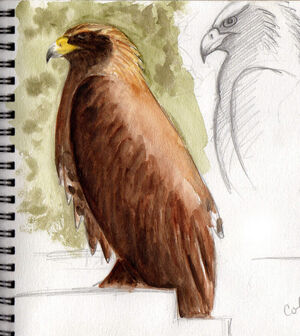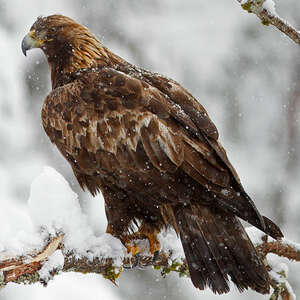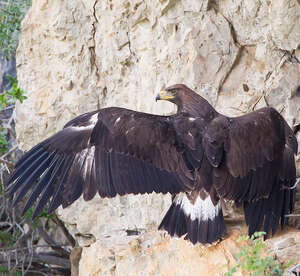Golden Eagle
Aquila chrysaetos - Aigle royal
Identification
The Golden Eagle is a large eagle, one of the largest in the world, with its wingspan exceeding 2 meters and the weight exceeding 5 kg. It is well proportioned and can make it appear smaller than it really is. It has a silhouette which is reminiscent from afar of a buzzard with its long 6-fingered wings. The wings are long and wide and the length of the tail is approximately equivalent to the width of the wing. The dark brown plumage appears fairly uniform from afar. The adult can be recognized by the reddish brown of the nape and back of the neck, a color which formerly earned it the name of the Golden Eagle. Furthermore, the medium chamois coverings on the wings form two clearly visible pale areas in flight and when perched. The primary and rectrix feathers have a clear base, which is strongly barred and a dark tip, which is easily visible in flight. When perched, note the large size of the bird, the strength of its talons and its oblique slit nostrils. The sexes differ only in size. The juvenile has darker brown plumage, with three very clearly visible white patches, formed by the base of the primary and rectrix feathers, which are very striking. It will take many years (from 5 to 8) for it to acquire the adult plumage and successive molts will gradually lighten the plumage and blur the light patches on its wings and tail. The Golden Eagle can be confused with other large eagles, but especially with the adult Spanish and Imperial Eagles in their respective habitats. These differ by their slightly different silhouette, particularly with a shorter and rounder tail, and mostly by their particular plumage characteristics (a more contrasted head with a brown-black face and a beige-cream nape and variable but highly visible white spots on the shoulders).
Subspecific information 6 subspecies
- Aquila chrysaetos chrysaetos (Europe to nc Asia)
- Aquila chrysaetos kamtschatica (ne Asia)
- Aquila chrysaetos japonica (Korea, Japan)
- Aquila chrysaetos daphanea (c Asia)
- Aquila chrysaetos homeyeri (Iberian Pen., n Africa through the Middle East to Iran and Uzbekistan)
- Aquila chrysaetos canadensis (Alaska, Canada, w USA, wc Mexico)
Foreign names
- Aigle royal,
- Águila real,
- águia-real,
- Steinadler,
- szirti sas,
- Steenarend,
- Aquila reale,
- kungsörn,
- Kongeørn,
- orol skalný,
- orel skalní,
- Kongeørn,
- maakotka,
- àguila daurada,
- Gullörn,
- orzeł przedni,
- klinšu ērglis,
- planinski orel,
- Беркут,
- イヌワシ,
- 金雕,
- kungsörn,
- 金鵰,
Voice song and call
Habitat
The Golden Eagle is a raptor of open wide spaces where it can hunt large prey, whatever the altitude and latitude.
Behaviour character trait
The Golden Eagle is a powerful raptor that acts as a superpredator. As mentioned before, it can be either sedentary or migratory.
Most of them are sedentary and occupy the same territory year-round. It is the wide range of predation that allows this sedentarism. In case of scarcity or unavailability of one of its prey, the eagle can redirect its hunting to other items. This is not the case for North American birds, which are forced to migrate due to the scarcity or unavailability of their main prey such as hibernating rodents. Due to its outstanding hunting capabilities, the Golden Eagle has been and is still used in falconry for hunting on the wing. This is a well-established tradition in Kazakhstan, where foxes are hunted in this way.Flight
The Golden Eagle is highly skilled at gliding. Its wings are slightly raised above its body, and it takes advantage of air currents to effortlessly rise and traverse mountain slopes, cresting ridges and taking to the skies to survey its territory.
Its wings riding the air provides it with powerful, sweeping movements. It can accelerate with lightning speed when it dives towards its prey on the ground. During the courtship ritual and aerial games, the birds chase each other and circle around, clashing talons, calling out their kyak noises. They finish with dizzying swoops back to their nesting ground.Dietfeeding habits
The Golden Eagle is a powerful raptor capable of attacking large prey such as hares and rabbits, young foxes, marmots, poultry, corvids, and smaller raptors such as buzzards, and then transporting them back to the nest, as long as their weight is not excessive.
Depending on the population, the main diet may consist of mammals or birds. The prey is caught on the ground, often by surprise after an initial scouting followed by a blind flight approach. He knows how to become a scavenger in times of scarcity or out of opportunism. This is how he can poison himself with lead shot by eating game picked up dead.Reproduction nesting
The nest is most often constructed in an inaccessible and dominant cliff face, sometimes in a tree. It is made of branches, some of them are quite large, and adorned with green elements.
It can measure up to 2 meters in width and several meters in height with the accumulation of new branches over the years. The couple usually has several nests that they occupy in alternation depending on the circumstances, those best placed being handed down from generation to generation. In March or April, the female lays 2 whitish eggs speckled with brown which she incubates for about 45 days. At first, only the male hunts to feed the female and the nestling. The female will not leave the nest until the young are sufficiently developed to stay alone. The golden eagle chicks will leave the nest at the age of two months to two and a half months, but will still remain dependent on their parents for a long time, sometimes even until the beginning of the following year.Geographic range
The Golden Eagle has a wide distribution throughout the Northern Hemisphere. It can be found from the Arctic Ocean in the north to desert (Mexico, Sahara and Arabian peninsula) or mountainous (Himalayas, Central China) areas in the south. It is sedentary in most of its range. Only the North American population (Alaska, Canada) is migratory and will spend the bad season in the West of the United States and the north of Mexico.
Threats - protection
IUCN conservation status
concern
in the Wild
threatened
evaluated
The Golden Eagle is not currently an endangered species (Least Concern by Birdlife International). It has previously suffered from human persecution, which caused it to disappear from many areas, but it is now protected by law in many countries. In western Europe, the population is estimated to be between 4,500 and 5,000 pairs. It is still common in the Alps, probably due to its summer prey, the marmot. Spain remains a stronghold for it. Despite official protection, it may still be subjected to malicious acts and direct destruction due to its predation of game species. Locally, it is still sought for falconry. New threats have appeared, such as the extension of the electrical network (electrocution, collisions), the development of wind energy (impact from the blades), the fight against predators / depredators (poisoning), etc.
Sources of information
- IOC World Bird List (v15.1), Gill, F and D Donsker (Eds). 2025-12-07.
Other sources of interest
 Specification sheet created on
09/07/2023 by Jean François
Specification sheet created on
09/07/2023 by Jean FrançoisTranslation by AI Oiseaux.net
© 1996-2026 Oiseaux.net
- Accipitriformes
- Aegotheliformes
- Anseriformes
- Apodiformes
- Apterygiformes
- Bucerotiformes
- Caprimulgiformes
- Cariamiformes
- Casuariiformes
- Charadriiformes
- Ciconiiformes
- Coliiformes
- Columbiformes
- Coraciiformes
- Cuculiformes
- Eurypygiformes
- Falconiformes
- Galliformes
- Gaviiformes
- Gruiformes
- Leptosomiformes
- Mesitornithiformes
- Musophagiformes
- Nyctibiiformes
- Opisthocomiformes
- Otidiformes
- Passeriformes
- Pelecaniformes
- Phaethontiformes
- Phoenicopteriformes
- Piciformes
- Podargiformes
- Podicipediformes
- Procellariiformes
- Psittaciformes
- Pterocliformes
- Rheiformes
- Sphenisciformes
- Steatornithiformes
- Strigiformes
- Struthioniformes
- Suliformes
- Tinamiformes
- Trogoniformes


































